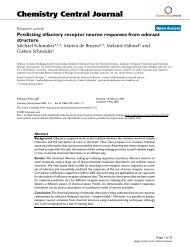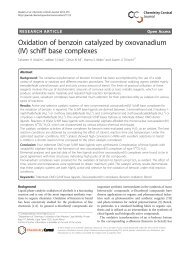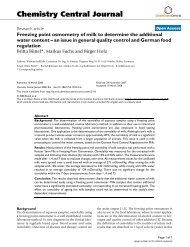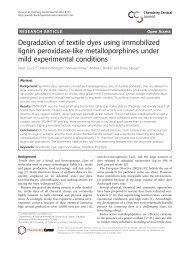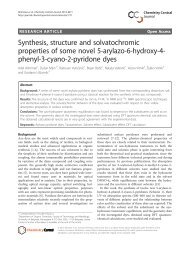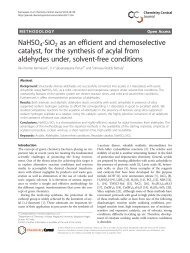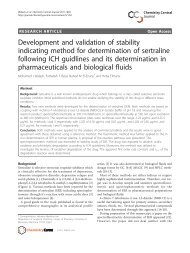Quinazoline derivatives: synthesis and bioactivities - Chemistry ...
Quinazoline derivatives: synthesis and bioactivities - Chemistry ...
Quinazoline derivatives: synthesis and bioactivities - Chemistry ...
You also want an ePaper? Increase the reach of your titles
YUMPU automatically turns print PDFs into web optimized ePapers that Google loves.
Wang <strong>and</strong> Gao <strong>Chemistry</strong> Central Journal 2013, 7:95 Page 6 of 15<br />
http://journal.chemistrycentral.com/content/7/1/95<br />
R 1<br />
N<br />
H<br />
X<br />
X=C,N<br />
Y=I,Br<br />
Y<br />
53<br />
H<br />
+<br />
H 2 N R 2<br />
54<br />
Ullmann<br />
Reaction R 1<br />
X<br />
10 mol% Cu(OAc) X<br />
2<br />
3equivK 2 CO 3<br />
R 1<br />
N<br />
DMSO, 110 ,Air<br />
N<br />
H<br />
NH Aerobic oxidation<br />
N<br />
R 2 55 C-H animation<br />
R 2 56<br />
Scheme 13 Copper-catalyzed <strong>synthesis</strong> of indolo[1,2-c]quinazoline <strong>derivatives</strong>.<br />
chemical molecules, have an urgent need for better synthetic<br />
methods. Classical copper-catalyzed Ullmann reaction<br />
has been widely studied due to its significant role in<br />
this regard. It raised attention from many chemists <strong>and</strong><br />
became one of the focal point in organic chemistry research<br />
in recent years. Sang et al. reported a coppercatalyzed<br />
sequential Ullmann N-arylation <strong>and</strong> aerobic<br />
oxidative C-H amination for the convenient <strong>synthesis</strong> of<br />
indolo[1,2-c]quinazoline <strong>derivatives</strong> [41]. In their research,<br />
2-(2-halophenyl)-1H-indoles <strong>and</strong> (aryl)methanamines were<br />
adopted as raw materials to generate corresponding Schiff<br />
base via Ullmann reaction. Then gas as oxidant, 3 equiv<br />
K 2 CO 3 as base, DMSO as solvent <strong>and</strong> 10 mol% Cu(OAc) 2<br />
as catalyst were revealed as the optimum conditions, to<br />
conduct aerobic oxidative C-H amination under 110°C<br />
(Scheme 13).Jiang et al. also reported a copper-catalyzed<br />
one-pot <strong>synthesis</strong> of 5,12-dihydroindolo[2,1-b]quinazolines<br />
[42]. The best conditions of catalyst, lig<strong>and</strong>, base <strong>and</strong><br />
solvent were determined as 10 mol% of CuI, 20 mol% of<br />
trans-4-hydroxyl-L-proline, 3.0 equiv of K 2 CO 3 ,DMSO<br />
<strong>and</strong> 90°C, respectively. N-(2-bromobenzyl)-2-iodoani-line<br />
(57) <strong>and</strong> malononitrile (58) were adopted as the raw<br />
materials to afford desired compound 59 through coppercatalyzed<br />
intramolecular C-N coupling reaction (Scheme 14).<br />
A two-step catalytic <strong>synthesis</strong> of 2-substituted-1,2,3,4-<br />
tetrahydroquinazolinones was investigated by Kundu et al.<br />
[43], including the palladium-copper co-catalyzed<br />
C-arylation of terminal alkynes <strong>and</strong> copper-catalyzed<br />
cyclization of disubstituted alkynes. First of all,<br />
2-(N-Alkyl-N-prop-2′-ynyl)amino-N’-p-tosyl benzamides<br />
<strong>and</strong> aryl iodides were adopted as the raw materials to react<br />
in presence of 5 equiv of Et 3 N for 16 h, catalyzed by<br />
2.5 mol% (Ph 3 P) 2 PhCl 2 <strong>and</strong> 5 mol% CuI, to generate a<br />
series of disubstituted alkynes. Then the products were<br />
cyclized in the presence of CuI (30 mol%), K 2 CO 3 (2.5<br />
equiv) <strong>and</strong> Bu 4 NBr (1 equiv) at 80°C for 16-24 h in CH 3 CN<br />
to afford the desired products 1-methyl(benzyl)-(E)-2-<br />
(2-arylvinyl)-3-p-tosyl-1,2,3,4-tetrahydroquinazoline-4-ones<br />
with high yield. The structures of obtained compounds<br />
wereshowninFigure1.<br />
Ultrasound-promoted <strong>synthesis</strong><br />
In critical <strong>synthesis</strong>, ultrasonic assistance is needed to<br />
meet the high requirements for temperature <strong>and</strong> pressure.<br />
For instance, in Bischler cyclization [44-46], the most<br />
traditional synthetic methods for quinazoline <strong>derivatives</strong>,<br />
high temperature (above 120°C) <strong>and</strong> high pressure are<br />
needed for at least 5 h in saturated ammonia alcohol solution.<br />
Various <strong>synthesis</strong> applying this method contains<br />
the passage of ammonia through a mixed melt of the<br />
amino compound <strong>and</strong> sodium acetate at a temperature<br />
higher than 160°C [47], in which ultrasonic promotion<br />
is dem<strong>and</strong>ed.<br />
Zhang et al. reported an ultrasound-assisted <strong>synthesis</strong><br />
of novel quinazoline <strong>derivatives</strong>, including a four-step<br />
<strong>synthesis</strong> of quinazoline core <strong>and</strong> the optimization of the<br />
Bischler cyclization [48]. The optimum reagents <strong>and</strong><br />
conditions of the four steps were as follows: (a) iron<br />
powder(reductant), concentrated HCl(catalyst), ethanol/<br />
water(co-solvents with V:V of 5:1), 50°C; (b) 4-nitrobenzoic<br />
acid chloride(1 equiv), TEA(1.2 equiv), DCM, 0°C; (c) 25%<br />
ammonia water, water, ultrasound 250 W, 80°C, 3 h; (d)<br />
iron powder, concentrated HCl, ethanol/water, 50°C<br />
(Scheme 15).<br />
Phase-transfer catalysis<br />
Phase-transfer catalysis (PTC) is considered to be one of<br />
the promising methods in organic <strong>synthesis</strong> of specialty<br />
chemicals. The previous 20 years sees a steady increment<br />
in articles <strong>and</strong> patents dealing with PTC topics<br />
<strong>and</strong> their applications. Currently, rather than be simply<br />
used in replacement reactions, PTC is widely applied in<br />
X<br />
R 1<br />
N<br />
H<br />
X=I,Br 57<br />
Br<br />
R 2<br />
EWG CuI, trans-4-OH-proline<br />
+<br />
K 2 CO 3 ,DMSO,90<br />
N C R<br />
58<br />
1<br />
EWG = CN, MeSO 2 ,<br />
PhSO 2 ,PO(OEt) 3<br />
EWG<br />
NH<br />
N<br />
59<br />
R 2<br />
Scheme 14 Copper-catalyzed one-pot <strong>synthesis</strong> of quinazolines <strong>derivatives</strong>.





